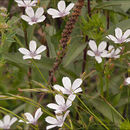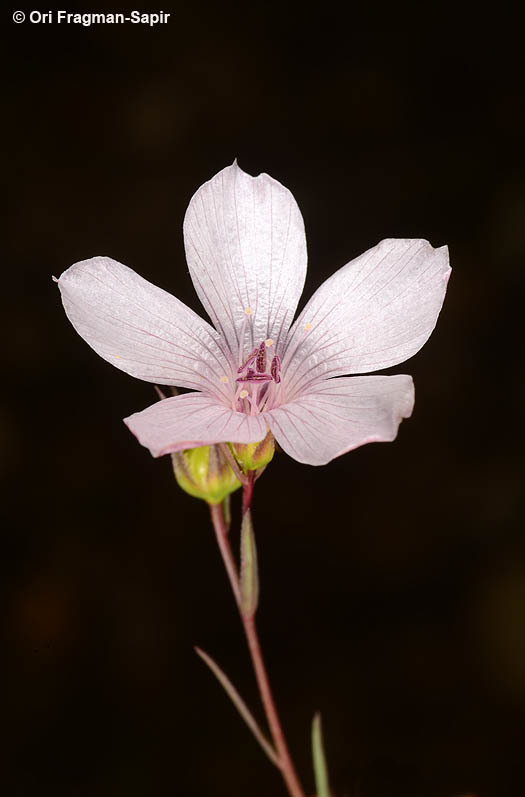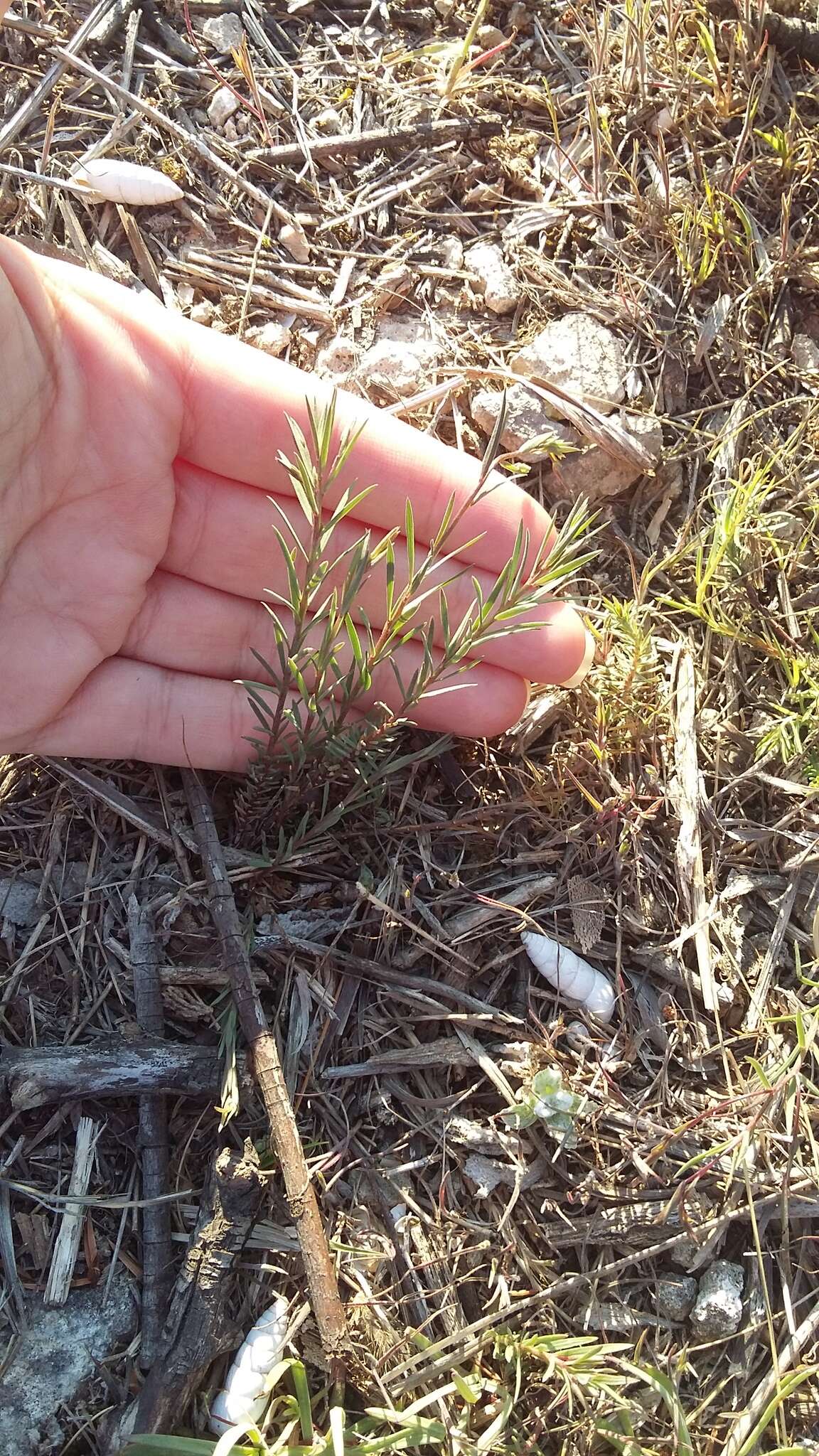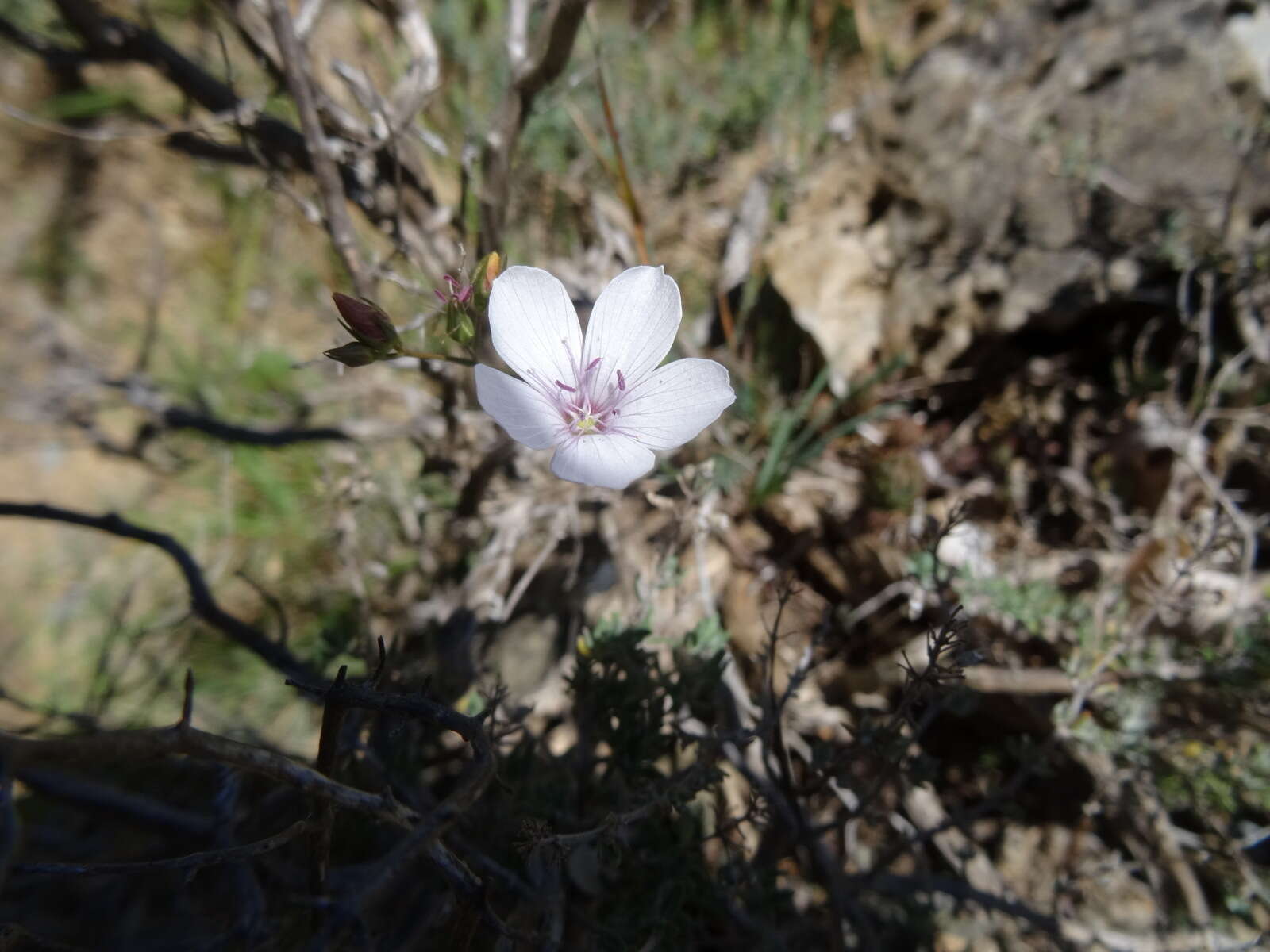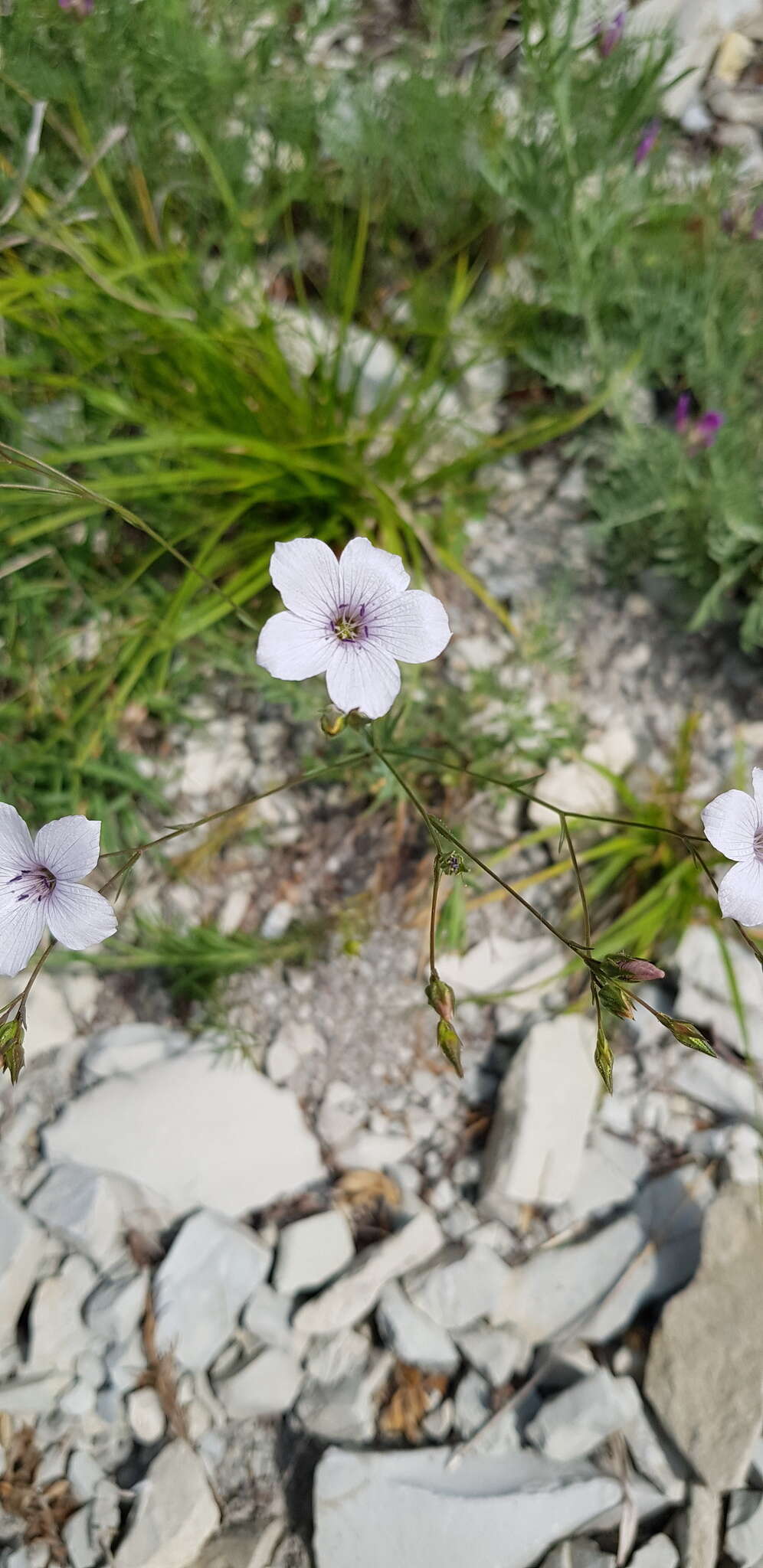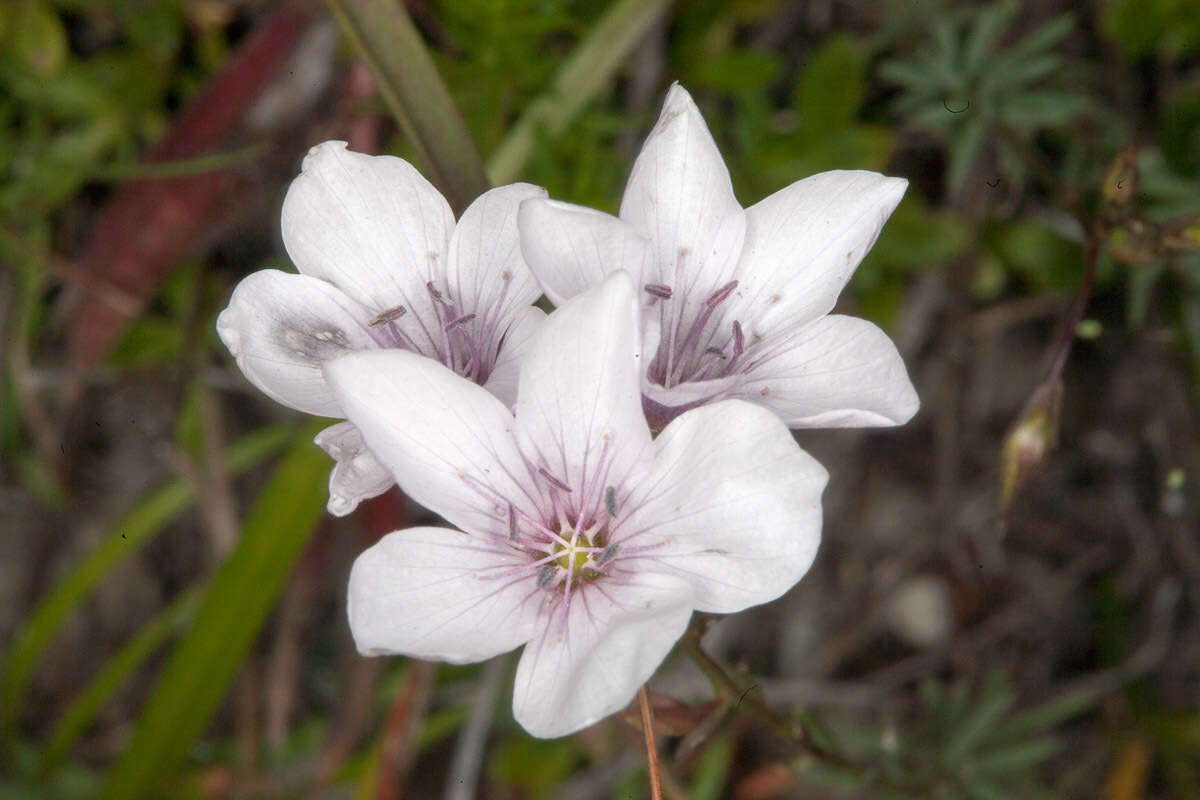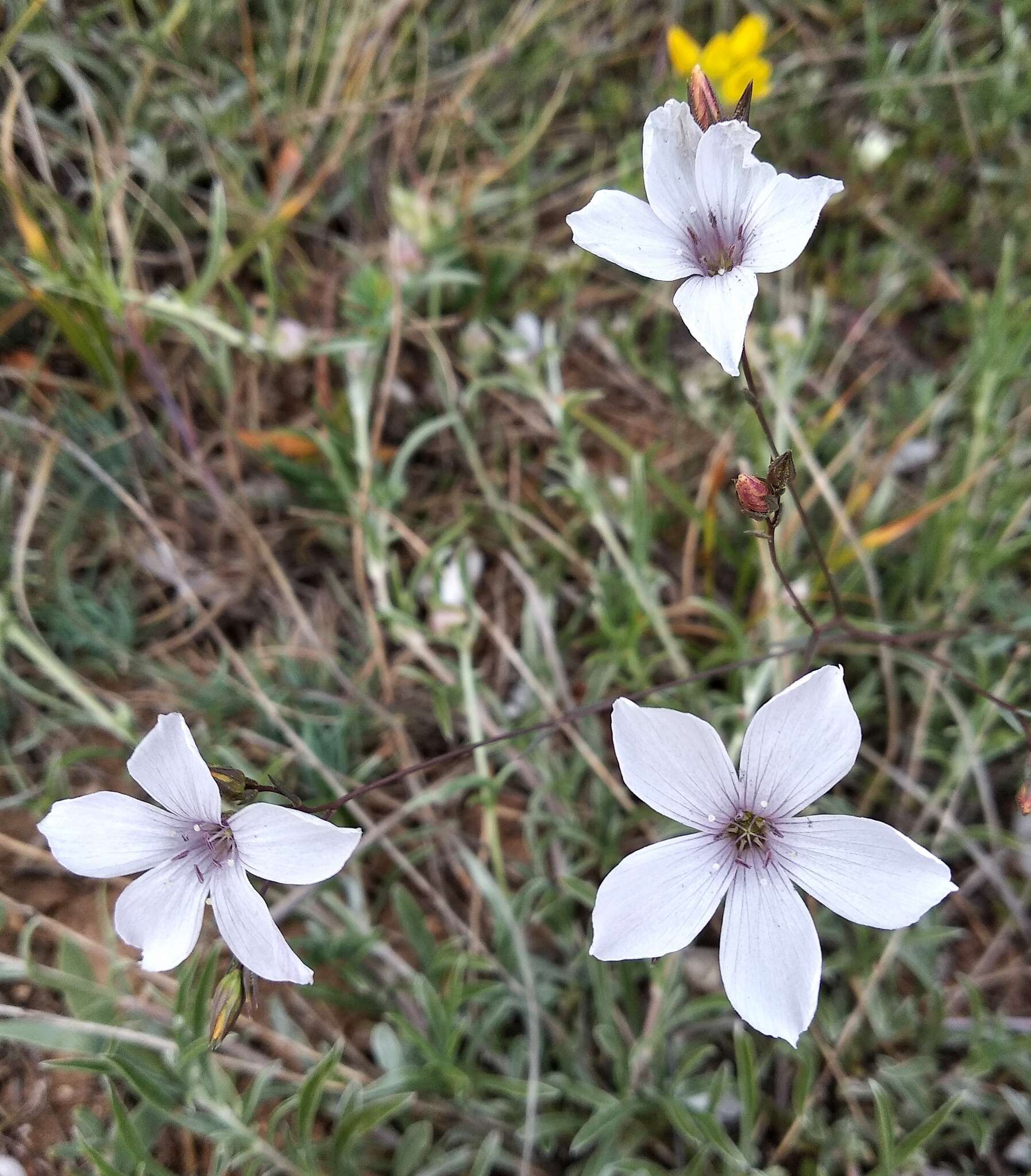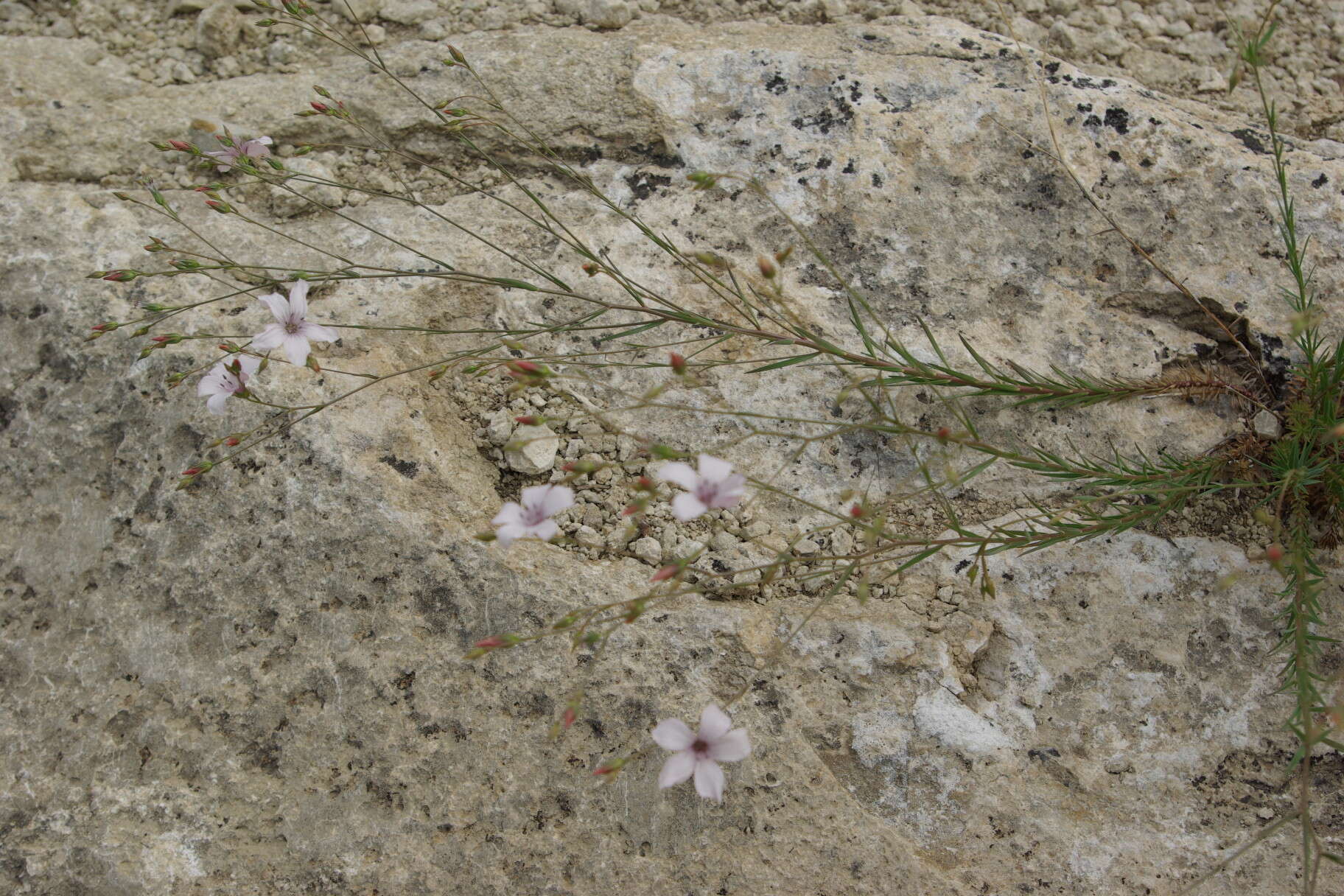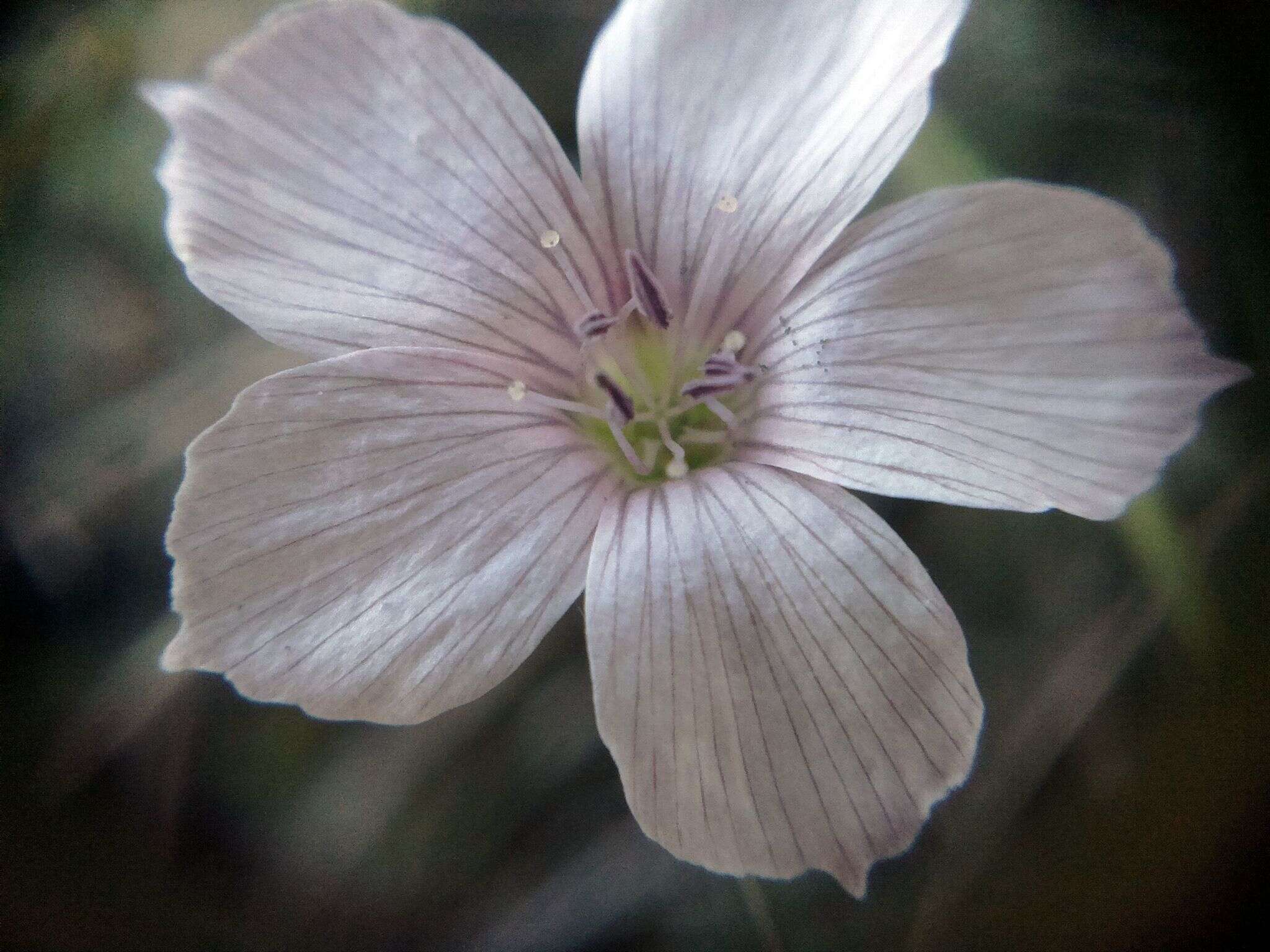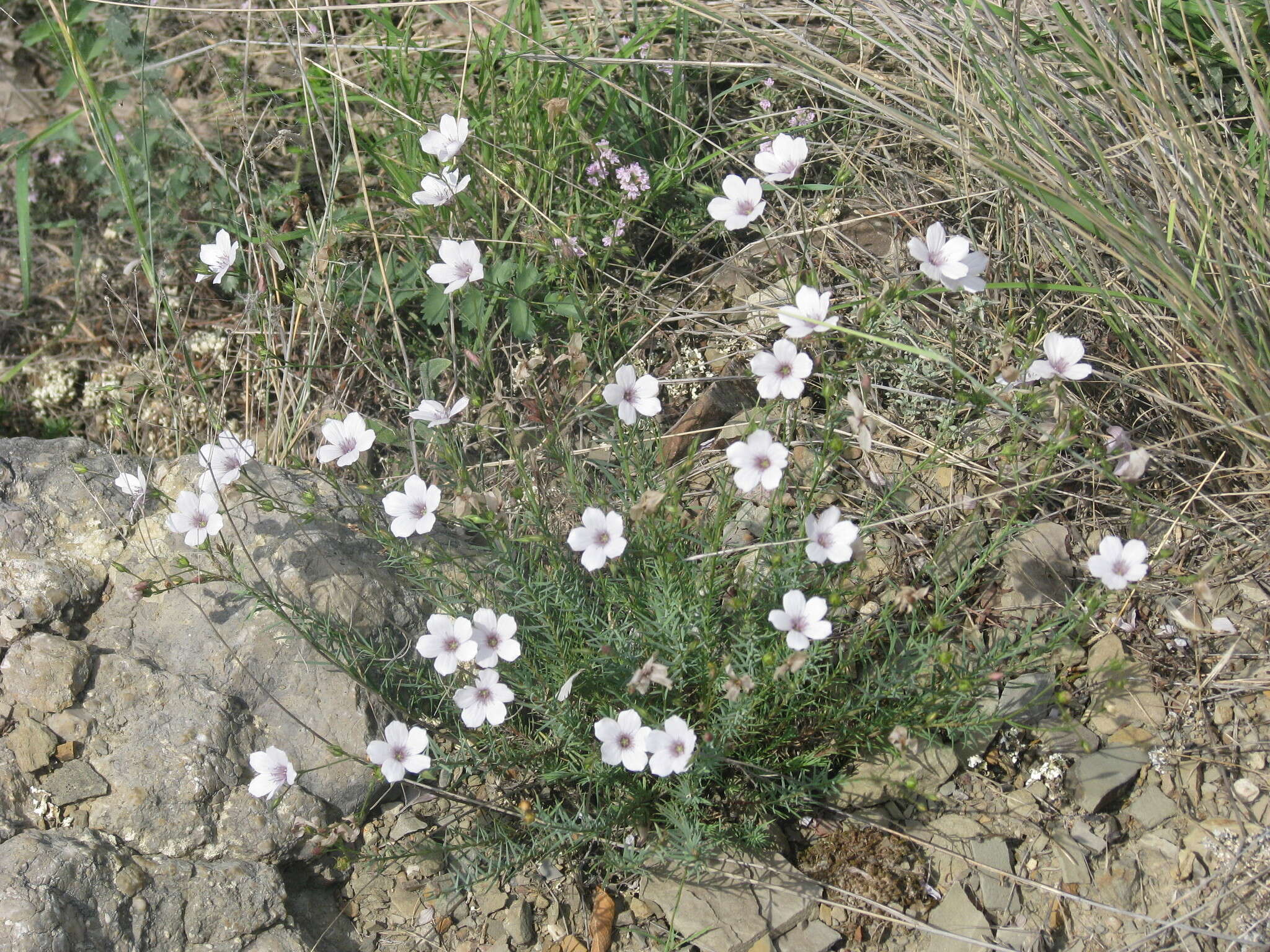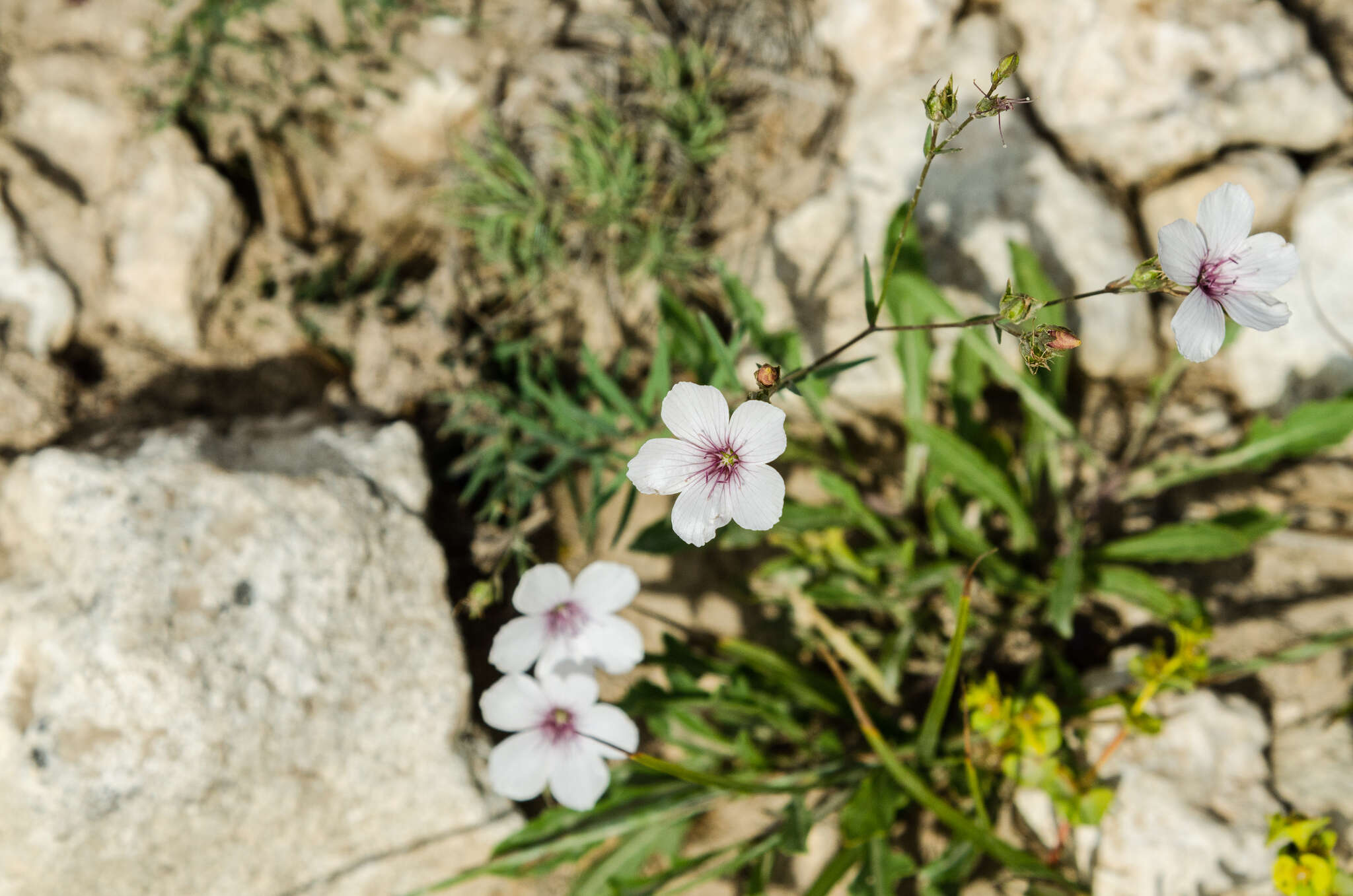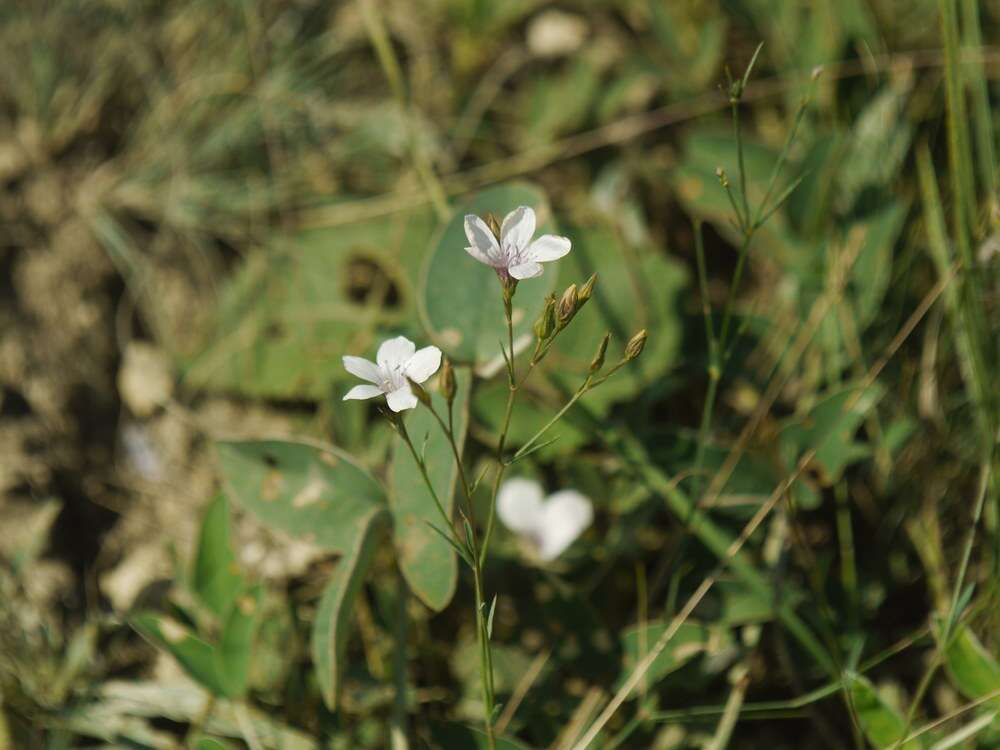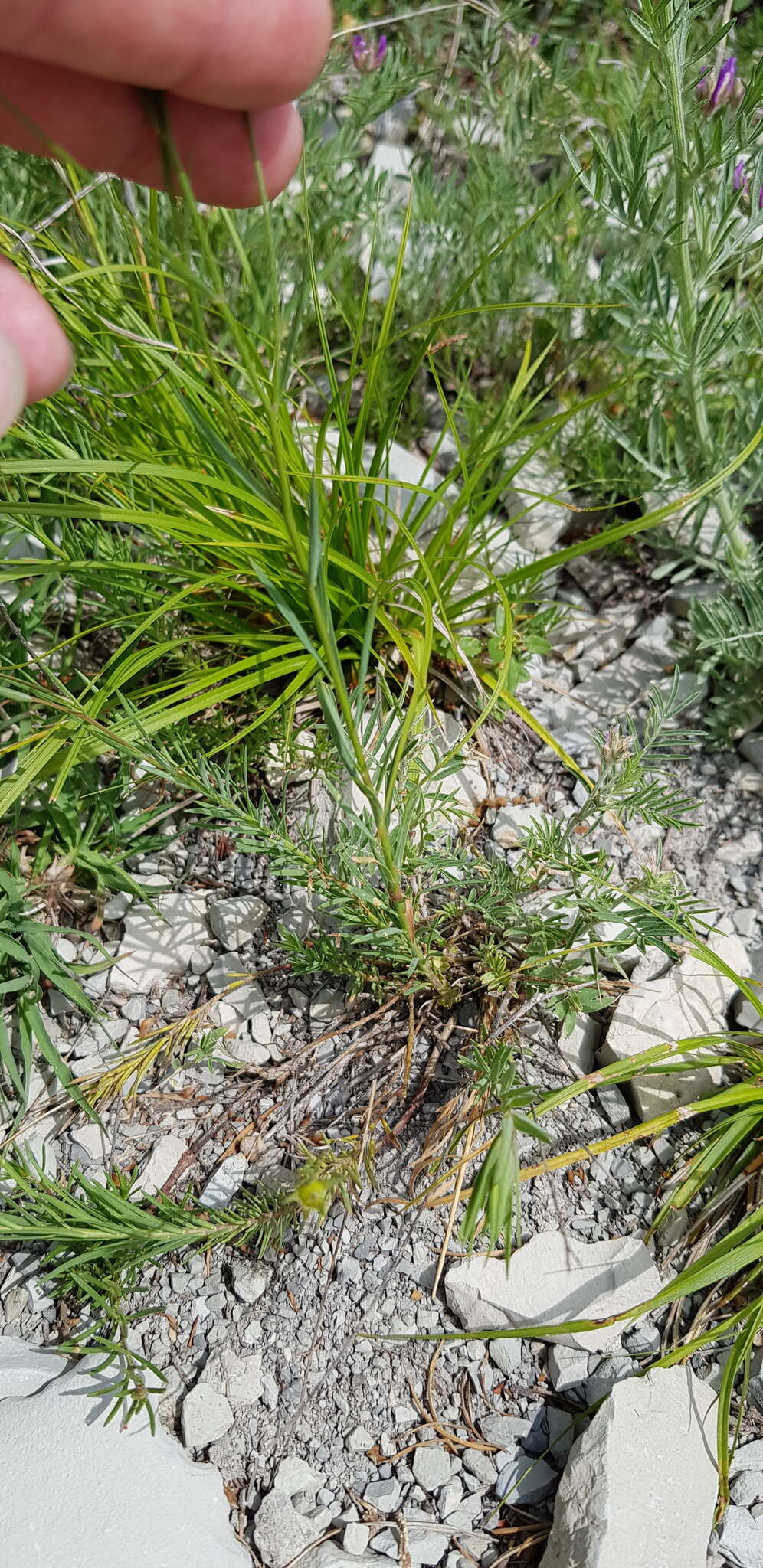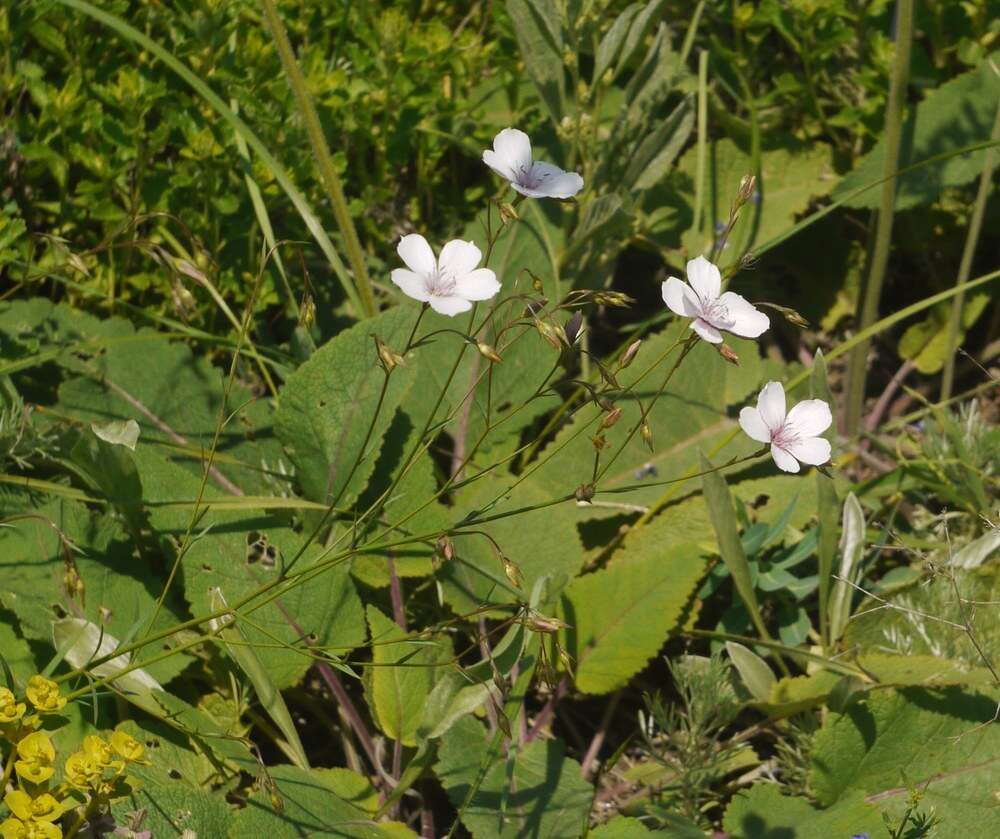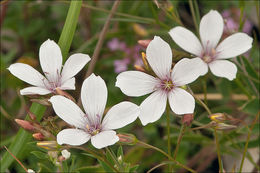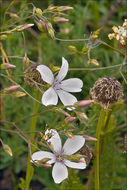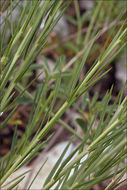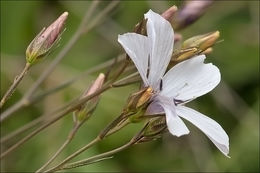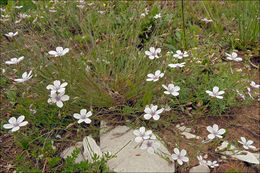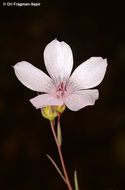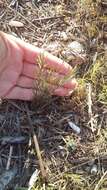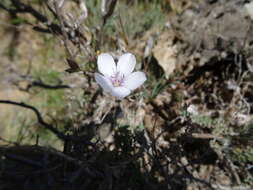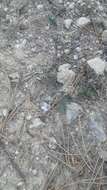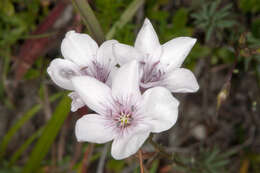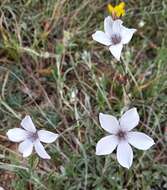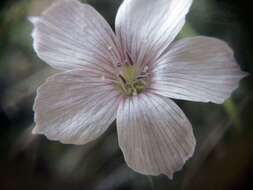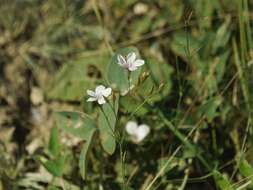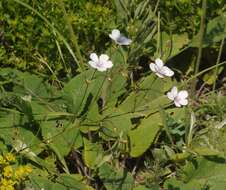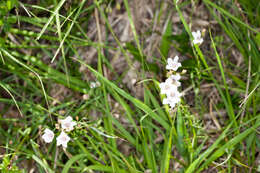-
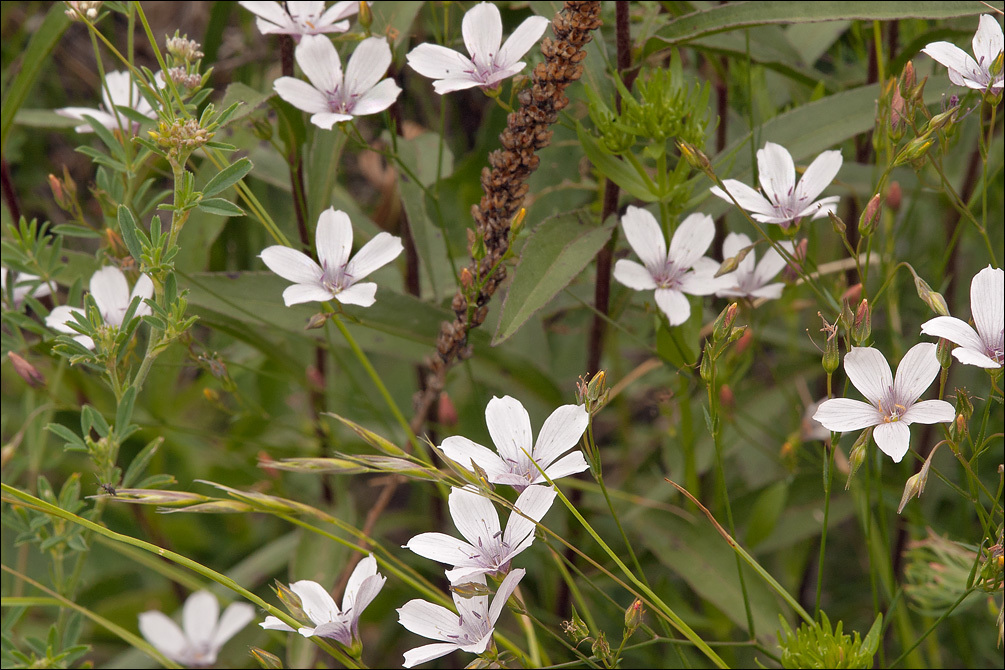
Slo.: drobnolistni lan - Habitat: sparsely overgrown, stony grassland, hill slope, west aspect, very shallow, skeletal, Karst type, calcareous ground; dry and warm place, exposed to direct rain; elevation 545 m (1.800 feet); average precipitations 1800-2200 mm/year, average temperature 7-9 deg C, Dinaric phytogeographical region. Substratum: stony, Karst red soil.Comment: Linum tenuifolium is a beautiful, tender and eye-catching plant like all other Linum species with larger flowers. It is actually a Mediterranean plant. But, it can be found also in most parts of south Alps and other parts of Europe.In spite of the fact that there are many species in the genus Linum (~ 200 worldwide, 36 in Europe and 18 growing in Slovenia), it is not difficult to identify it. It can be easily recognized by numerous very pale pink or violet, almost white flowers with darker veins and characteristic single nerve, strongly pointed sepals, which have pronounced, stiff, glandular hairs along their edges (see picture 6). Leaves are very narrow, single nerved and have very small but sharp teeth along their edges (loupe!). Also dry, stony, nutrients poor habitat, where it grows, is typical. Growing mostly in low 'bushes' with numerous more or less radially arranged flowering stalks.Ref.:(1) M.A. Fischer, W. Adler, K. Oswald, Exkursionsflora fr sterreich, Liechtenstein und Sdtirol, LO Landesmuseen, Linz, Austria (2005), p 454.(2) A. Martini et all., Mala Flora Slovenije (Flora of Slovenia - Key) (in Slovenian), Tehnina Zaloba Slovenije (2007), p 346. (3) D. Seidel, Blumen am Mittelmeer, BLV (2002), p 171.(4) D. Aeschimann, K. Lauber, D.M. Moser, J.P. Theurillat, Flora Alpina, Vol. 1., Haupt (2004), p 1030.(5) K. Lauber and G. Wagner, Flora Helvetica, 5. Auflage, Haupt (2012), p 444.
-
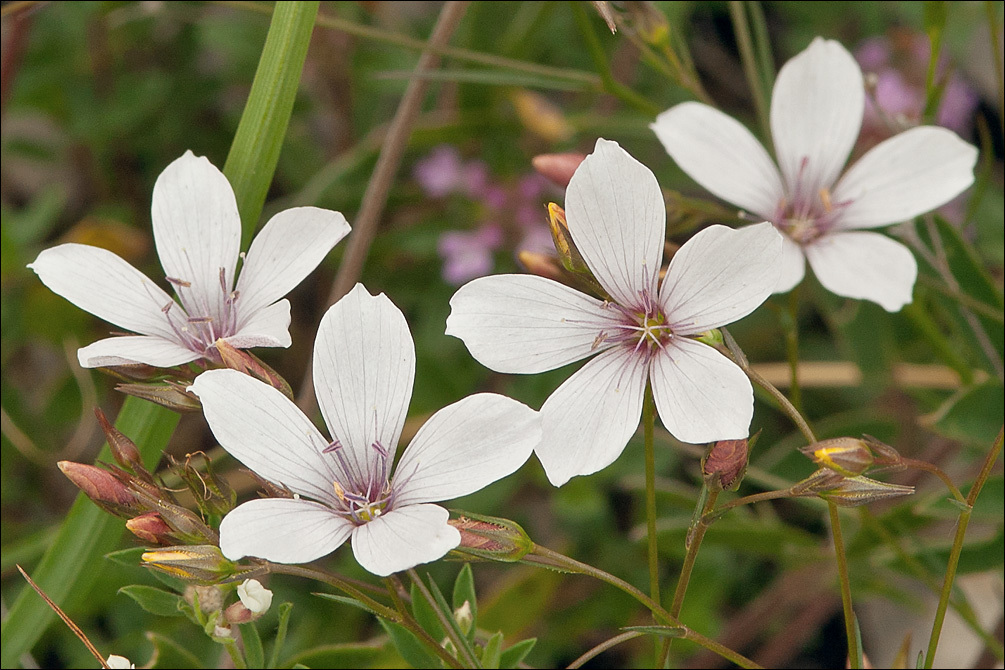
Slo.: drobnolistni lan - Habitat: sparsely overgrown, stony grassland, hill slope, west aspect, very shallow, skeletal, Karst type, calcareous ground; dry and warm place, exposed to direct rain; elevation 545 m (1.800 feet); average precipitations 1800-2200 mm/year, average temperature 7-9 deg C, Dinaric phytogeographical region. Substratum: stony, Karst red soil. Comment: Linum tenuifolium is a beautiful, tender and eye-catching plant like all other Linum species with larger flowers. It is actually a Mediterranean plant. But, it can be found also in most parts of south Alps and other parts of Europe. In spite of the fact that there are many species in the genus Linum (~ 200 worldwide, 36 in Europe and 18 growing in Slovenia), it is not difficult to identify it. It can be easily recognized by numerous very pale pink or violet, almost white flowers with darker veins and characteristic single nerve, strongly pointed sepals, which have pronounced, stiff, glandular hairs along their edges (see picture 6). Leaves are very narrow, single nerved and have very small but sharp teeth along their edges (loupe!). Also dry, stony, nutrients poor habitat, where it grows, is typical. Growing mostly in low 'bushes' with numerous more or less radially arranged flowering stalks. Ref.: (1) M.A. Fischer, W. Adler, K. Oswald, Exkursionsflora fr sterreich, Liechtenstein und Sdtirol, LO Landesmuseen, Linz, Austria (2005), p 454. (2) A. Martini et all., Mala Flora Slovenije (Flora of Slovenia - Key) (in Slovenian), Tehnina Zaloba Slovenije (2007), p 346. (3) D. Seidel, Blumen am Mittelmeer, BLV (2002), p 171. (4) D. Aeschimann, K. Lauber, D.M. Moser, J.P. Theurillat, Flora Alpina, Vol. 1., Haupt (2004), p 1030. (5) K. Lauber and G. Wagner, Flora Helvetica, 5. Auflage, Haupt (2012), p 444.
-
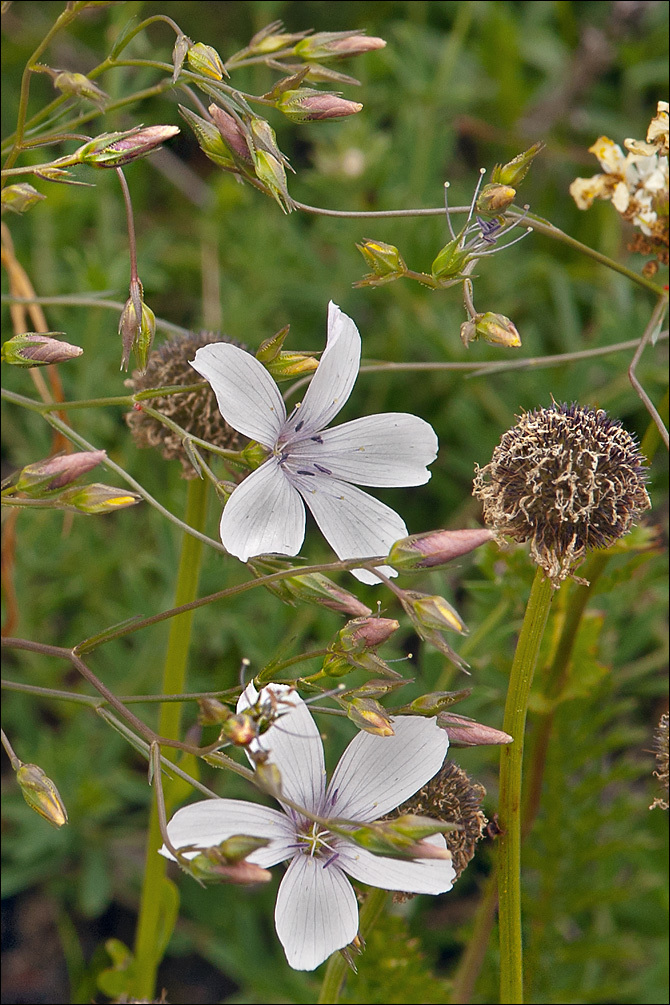
Slo.: drobnolistni lan - Habitat: sparsely overgrown, stony grassland, hill slope, west aspect, very shallow, skeletal, Karst type, calcareous ground; dry and warm place, exposed to direct rain; elevation 545 m (1.800 feet); average precipitations 1800-2200 mm/year, average temperature 7-9 deg C, Dinaric phytogeographical region. Substratum: stony, Karst red soil. Comment: Linum tenuifolium is a beautiful, tender and eye-catching plant like all other Linum species with larger flowers. It is actually a Mediterranean plant. But, it can be found also in most parts of south Alps and other parts of Europe. In spite of the fact that there are many species in the genus Linum (~ 200 worldwide, 36 in Europe and 18 growing in Slovenia), it is not difficult to identify it. It can be easily recognized by numerous very pale pink or violet, almost white flowers with darker veins and characteristic single nerve, strongly pointed sepals, which have pronounced, stiff, glandular hairs along their edges (see picture 6). Leaves are very narrow, single nerved and have very small but sharp teeth along their edges (loupe!). Also dry, stony, nutrients poor habitat, where it grows, is typical. Growing mostly in low 'bushes' with numerous more or less radially arranged flowering stalks. Ref.: (1) M.A. Fischer, W. Adler, K. Oswald, Exkursionsflora fr sterreich, Liechtenstein und Sdtirol, LO Landesmuseen, Linz, Austria (2005), p 454. (2) A. Martini et all., Mala Flora Slovenije (Flora of Slovenia - Key) (in Slovenian), Tehnina Zaloba Slovenije (2007), p 346. (3) D. Seidel, Blumen am Mittelmeer, BLV (2002), p 171. (4) D. Aeschimann, K. Lauber, D.M. Moser, J.P. Theurillat, Flora Alpina, Vol. 1., Haupt (2004), p 1030. (5) K. Lauber and G. Wagner, Flora Helvetica, 5. Auflage, Haupt (2012), p 444.
-
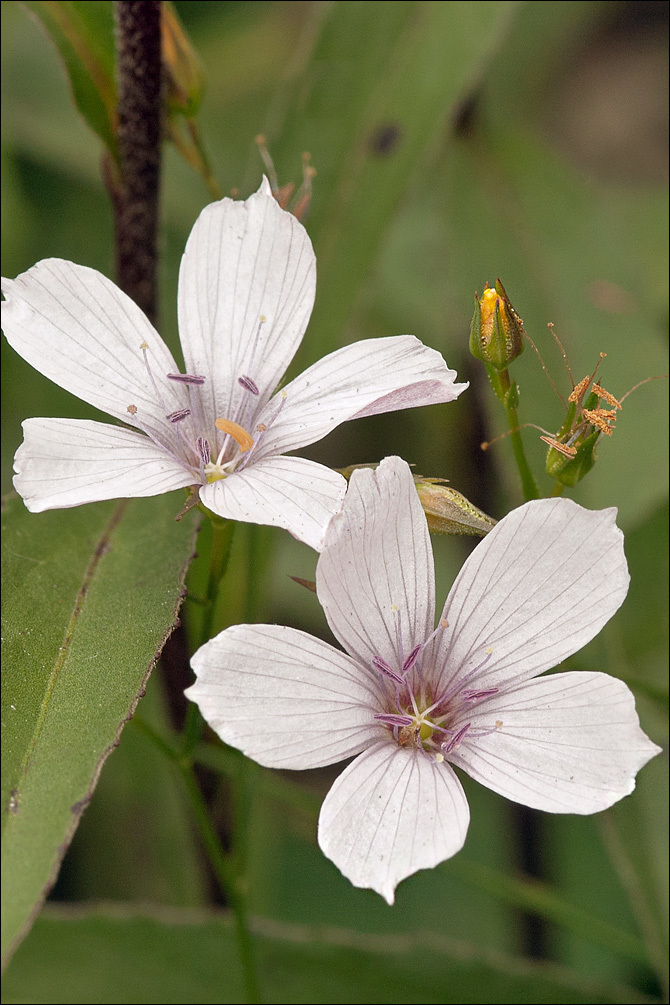
Slo.: drobnolistni lan - Habitat: sparsely overgrown, stony grassland, hill slope, west aspect, very shallow, skeletal, Karst type, calcareous ground; dry and warm place, exposed to direct rain; elevation 545 m (1.800 feet); average precipitations 1800-2200 mm/year, average temperature 7-9 deg C, Dinaric phytogeographical region. Substratum: stony, Karst red soil. Comment: Linum tenuifolium is a beautiful, tender and eye-catching plant like all other Linum species with larger flowers. It is actually a Mediterranean plant. But, it can be found also in most parts of south Alps and other parts of Europe. In spite of the fact that there are many species in the genus Linum (~ 200 worldwide, 36 in Europe and 18 growing in Slovenia), it is not difficult to identify it. It can be easily recognized by numerous very pale pink or violet, almost white flowers with darker veins and characteristic single nerve, strongly pointed sepals, which have pronounced, stiff, glandular hairs along their edges (see picture 6). Leaves are very narrow, single nerved and have very small but sharp teeth along their edges (loupe!). Also dry, stony, nutrients poor habitat, where it grows, is typical. Growing mostly in low 'bushes' with numerous more or less radially arranged flowering stalks. Ref.: (1) M.A. Fischer, W. Adler, K. Oswald, Exkursionsflora fr sterreich, Liechtenstein und Sdtirol, LO Landesmuseen, Linz, Austria (2005), p 454. (2) A. Martini et all., Mala Flora Slovenije (Flora of Slovenia - Key) (in Slovenian), Tehnina Zaloba Slovenije (2007), p 346. (3) D. Seidel, Blumen am Mittelmeer, BLV (2002), p 171. (4) D. Aeschimann, K. Lauber, D.M. Moser, J.P. Theurillat, Flora Alpina, Vol. 1., Haupt (2004), p 1030. (5) K. Lauber and G. Wagner, Flora Helvetica, 5. Auflage, Haupt (2012), p 444.
-

Slo.: drobnolistni lan - Habitat: sparsely overgrown, stony grassland, hill slope, west aspect, very shallow, skeletal, Karst type, calcareous ground; dry and warm place, exposed to direct rain; elevation 545 m (1.800 feet); average precipitations 1800-2200 mm/year, average temperature 7-9 deg C, Dinaric phytogeographical region. Substratum: stony, Karst red soil. Comment: Linum tenuifolium is a beautiful, tender and eye-catching plant like all other Linum species with larger flowers. It is actually a Mediterranean plant. But, it can be found also in most parts of south Alps and other parts of Europe. In spite of the fact that there are many species in the genus Linum (~ 200 worldwide, 36 in Europe and 18 growing in Slovenia), it is not difficult to identify it. It can be easily recognized by numerous very pale pink or violet, almost white flowers with darker veins and characteristic single nerve, strongly pointed sepals, which have pronounced, stiff, glandular hairs along their edges (see picture 6). Leaves are very narrow, single nerved and have very small but sharp teeth along their edges (loupe!). Also dry, stony, nutrients poor habitat, where it grows, is typical. Growing mostly in low 'bushes' with numerous more or less radially arranged flowering stalks. Ref.: (1) M.A. Fischer, W. Adler, K. Oswald, Exkursionsflora fr sterreich, Liechtenstein und Sdtirol, LO Landesmuseen, Linz, Austria (2005), p 454. (2) A. Martini et all., Mala Flora Slovenije (Flora of Slovenia - Key) (in Slovenian), Tehnina Zaloba Slovenije (2007), p 346. (3) D. Seidel, Blumen am Mittelmeer, BLV (2002), p 171. (4) D. Aeschimann, K. Lauber, D.M. Moser, J.P. Theurillat, Flora Alpina, Vol. 1., Haupt (2004), p 1030. (5) K. Lauber and G. Wagner, Flora Helvetica, 5. Auflage, Haupt (2012), p 444.
-
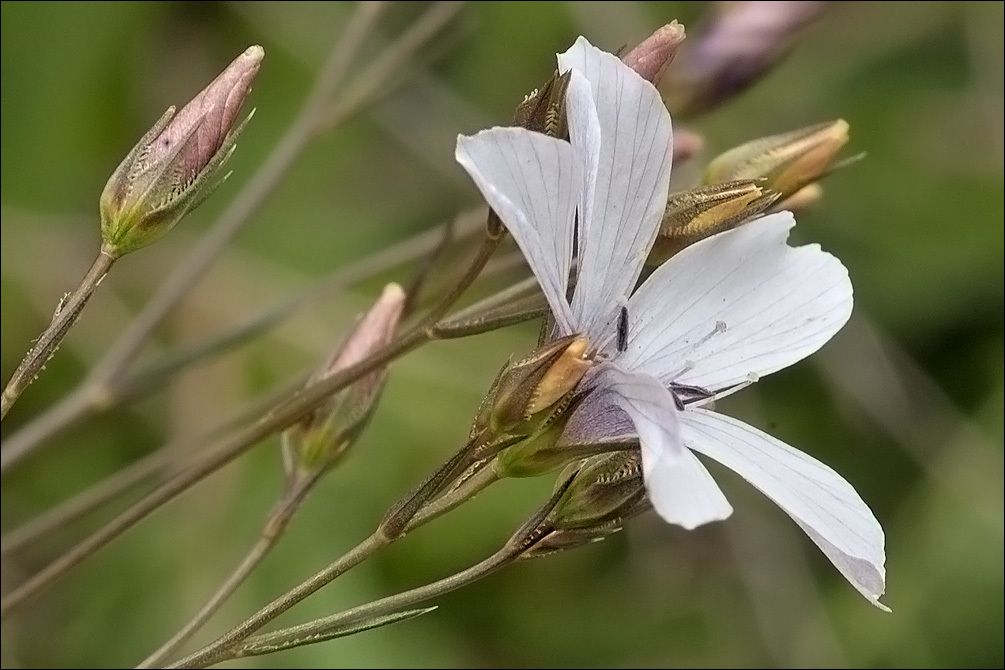
Slo.: drobnolistni lan - Habitat: sparsely overgrown, stony grassland, hill slope, west aspect, very shallow, skeletal, Karst type, calcareous ground; dry and warm place, exposed to direct rain; elevation 545 m (1.800 feet); average precipitations 1800-2200 mm/year, average temperature 7-9 deg C, Dinaric phytogeographical region. Substratum: stony, Karst red soil. Comment: Linum tenuifolium is a beautiful, tender and eye-catching plant like all other Linum species with larger flowers. It is actually a Mediterranean plant. But, it can be found also in most parts of south Alps and other parts of Europe. In spite of the fact that there are many species in the genus Linum (~ 200 worldwide, 36 in Europe and 18 growing in Slovenia), it is not difficult to identify it. It can be easily recognized by numerous very pale pink or violet, almost white flowers with darker veins and characteristic single nerve, strongly pointed sepals, which have pronounced, stiff, glandular hairs along their edges (see picture 6). Leaves are very narrow, single nerved and have very small but sharp teeth along their edges (loupe!). Also dry, stony, nutrients poor habitat, where it grows, is typical. Growing mostly in low 'bushes' with numerous more or less radially arranged flowering stalks. Ref.: (1) M.A. Fischer, W. Adler, K. Oswald, Exkursionsflora fr sterreich, Liechtenstein und Sdtirol, LO Landesmuseen, Linz, Austria (2005), p 454. (2) A. Martini et all., Mala Flora Slovenije (Flora of Slovenia - Key) (in Slovenian), Tehnina Zaloba Slovenije (2007), p 346. (3) D. Seidel, Blumen am Mittelmeer, BLV (2002), p 171. (4) D. Aeschimann, K. Lauber, D.M. Moser, J.P. Theurillat, Flora Alpina, Vol. 1., Haupt (2004), p 1030. (5) K. Lauber and G. Wagner, Flora Helvetica, 5. Auflage, Haupt (2012), p 444.
-
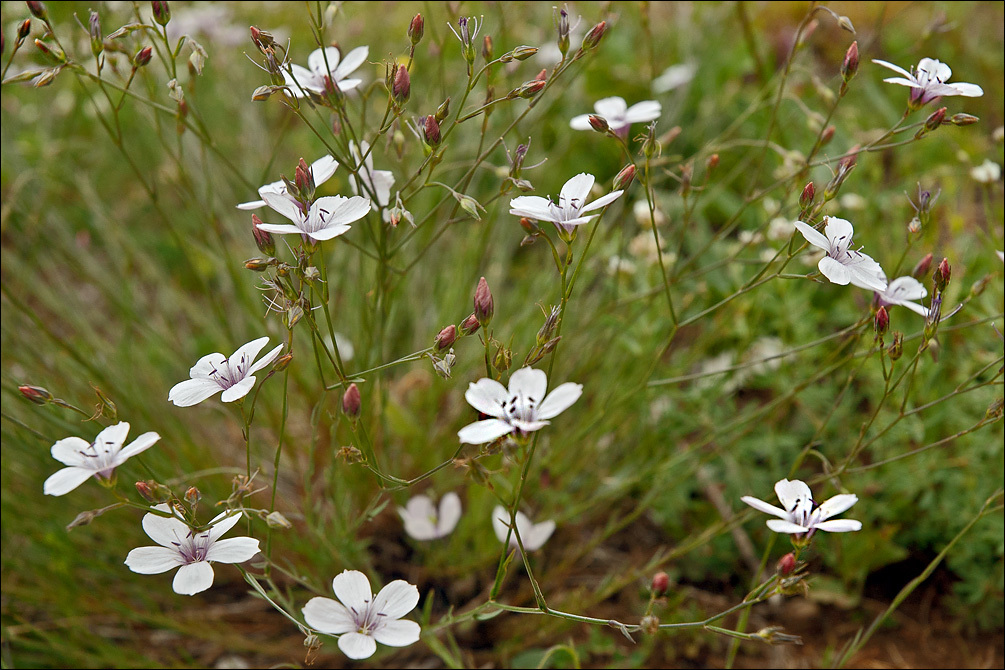
Slo.: drobnolistni lan - Habitat: sparsely overgrown, stony grassland, hill slope, west aspect, very shallow, skeletal, Karst type, calcareous ground; dry and warm place, exposed to direct rain; elevation 545 m (1.800 feet); average precipitations 1800-2200 mm/year, average temperature 7-9 deg C, Dinaric phytogeographical region. Substratum: stony, Karst red soil. Comment: Linum tenuifolium is a beautiful, tender and eye-catching plant like all other Linum species with larger flowers. It is actually a Mediterranean plant. But, it can be found also in most parts of south Alps and other parts of Europe. In spite of the fact that there are many species in the genus Linum (~ 200 worldwide, 36 in Europe and 18 growing in Slovenia), it is not difficult to identify it. It can be easily recognized by numerous very pale pink or violet, almost white flowers with darker veins and characteristic single nerve, strongly pointed sepals, which have pronounced, stiff, glandular hairs along their edges (see picture 6). Leaves are very narrow, single nerved and have very small but sharp teeth along their edges (loupe!). Also dry, stony, nutrients poor habitat, where it grows, is typical. Growing mostly in low 'bushes' with numerous more or less radially arranged flowering stalks. Ref.: (1) M.A. Fischer, W. Adler, K. Oswald, Exkursionsflora fr sterreich, Liechtenstein und Sdtirol, LO Landesmuseen, Linz, Austria (2005), p 454. (2) A. Martini et all., Mala Flora Slovenije (Flora of Slovenia - Key) (in Slovenian), Tehnina Zaloba Slovenije (2007), p 346. (3) D. Seidel, Blumen am Mittelmeer, BLV (2002), p 171. (4) D. Aeschimann, K. Lauber, D.M. Moser, J.P. Theurillat, Flora Alpina, Vol. 1., Haupt (2004), p 1030. (5) K. Lauber and G. Wagner, Flora Helvetica, 5. Auflage, Haupt (2012), p 444.
-
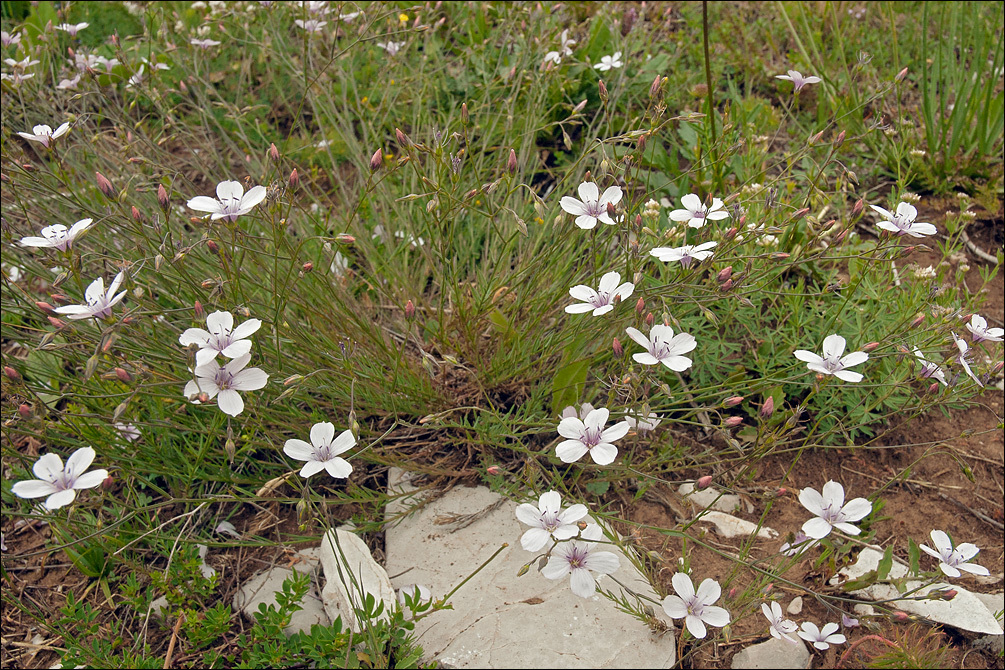
Slo.: drobnolistni lan - Habitat: sparsely overgrown, stony grassland, hill slope, west aspect, very shallow, skeletal, Karst type, calcareous ground; dry and warm place, exposed to direct rain; elevation 545 m (1.800 feet); average precipitations 1800-2200 mm/year, average temperature 7-9 deg C, Dinaric phytogeographical region. Substratum: stony, Karst red soil. Comment: Linum tenuifolium is a beautiful, tender and eye-catching plant like all other Linum species with larger flowers. It is actually a Mediterranean plant. But, it can be found also in most parts of south Alps and other parts of Europe. In spite of the fact that there are many species in the genus Linum (~ 200 worldwide, 36 in Europe and 18 growing in Slovenia), it is not difficult to identify it. It can be easily recognized by numerous very pale pink or violet, almost white flowers with darker veins and characteristic single nerve, strongly pointed sepals, which have pronounced, stiff, glandular hairs along their edges (see picture 6). Leaves are very narrow, single nerved and have very small but sharp teeth along their edges (loupe!). Also dry, stony, nutrients poor habitat, where it grows, is typical. Growing mostly in low 'bushes' with numerous more or less radially arranged flowering stalks. Ref.: (1) M.A. Fischer, W. Adler, K. Oswald, Exkursionsflora fr sterreich, Liechtenstein und Sdtirol, LO Landesmuseen, Linz, Austria (2005), p 454. (2) A. Martini et all., Mala Flora Slovenije (Flora of Slovenia - Key) (in Slovenian), Tehnina Zaloba Slovenije (2007), p 346. (3) D. Seidel, Blumen am Mittelmeer, BLV (2002), p 171. (4) D. Aeschimann, K. Lauber, D.M. Moser, J.P. Theurillat, Flora Alpina, Vol. 1., Haupt (2004), p 1030. (5) K. Lauber and G. Wagner, Flora Helvetica, 5. Auflage, Haupt (2012), p 444.
-
This is a delicate and beautiful perennial flax.
-
-
-
-
-
-
-
-
-
-
-
-
-
-
-

